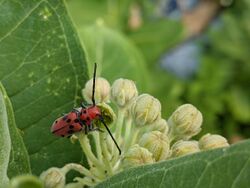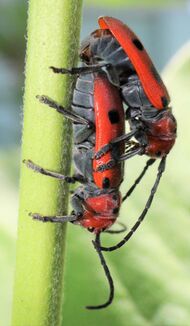Biology:Tetraopes tetrophthalmus
| Red milkweed beetle | |
|---|---|

| |
| Scientific classification | |
| Domain: | Eukaryota |
| Kingdom: | Animalia |
| Phylum: | Arthropoda |
| Class: | Insecta |
| Order: | Coleoptera |
| Infraorder: | Cucujiformia |
| Family: | Cerambycidae |
| Subfamily: | Lamiinae |
| Genus: | Tetraopes |
| Species: | T. tetrophthalmus
|
| Binomial name | |
| Tetraopes tetrophthalmus (Forster, 1771)
| |
| Synonyms | |
| |
The red milkweed beetle (Tetraopes tetrophthalmus) is a beetle in the family Cerambycidae.
Explanation of names
The binomial genus and species names are both derived from the Ancient Greek for "four eyes." As in many longhorn beetles, the antennae are situated very near the eye–in the red milkweed beetle, this adaptation has been carried to an extreme: the antennal base actually bisects the eye (See Fig. 1).
Host plants
The milkweed beetle, a herbivore, is given this name because it is host-specific to common milkweed (Asclepias syriaca).[1] It has been reported on horsetail milkweed (Asclepias verticillata) in a disturbed site in Illinois.[1]:81[2]
Toxicity
It is thought the beetle, which as an adult feeds on the foliage of the plant, and its early instars, which eat the roots,[3][4] derive a measure of protection from predators by incorporating toxins from the plant into their bodies, thereby becoming distasteful, much as the monarch butterfly and its larvae do.[5]
Behavior
These beetles feed by opening veins in the milkweed plant, decreasing the beetles' exposure to latex-like sap.[6] When startled, the beetles make a shrill noise, while they make a 'purring' noise when interacting with another beetle.[6] The red and black coloring are aposematic, advertising the beetles' inedibility. Red milkweed beetles lay egg-clutches in mid-summer inside the stem base of the milkweed plant.[7]
References
- ↑ 1.0 1.1 Price, Peter W.; Willson, Mary F. (1979). "Abundance of Herbivores on Six Milkweed Species in Illinois". The American Midland Naturalist 101 (1): 76-86. doi:10.2307/2424903.
- ↑ Price, Peter W.; Willson, Mary F. (1976). "Some consequences for a parasitic herbivore, the milkweed longhorn beetle, Tetraopes tetrophthalmus, of a host-plant shift from Asdepias syriaca to A. verticillata". Oecologia 25 (4): 331-340. doi:10.1007/BF00345606.
- ↑ Erwin, Alexis C.; Züst, Tobias; Ali, Jared G.; Agrawal, Anurag A. (2014). "Above-ground herbivory by red milkweed beetles facilitates above- and below-ground conspecific insects and reduces fruit production in common milkweed". Journal of Ecology 102 (4): 1038-1047. doi:10.1111/1365-2745.12248.
- ↑ Christophersen, Megan (April 2014). "Interactions". University of Wisconsin La Crosse. http://bioweb.uwlax.edu/bio203/s2014/christop_mega/interactions.htm.
- ↑ Felt, Alison (April 2014). "Habitat". University of Wisconsin La Crosse. http://bioweb.uwlax.edu/bio203/s2014/christop_mega/habitat.htm.
- ↑ 6.0 6.1 Felt, Alison (April 2014). "Form and Function". University of Wisconsin La Crosse. http://bioweb.uwlax.edu/bio203/s2014/christop_mega/adaptation.htm.
- ↑ Christophersen, Megan (April 2014). "Reproduction". University of Wisconsin La Crosse. http://bioweb.uwlax.edu/bio203/s2014/christop_mega/nutrition.htm.
External links
Wikidata ☰ Q577252 entry
 |



